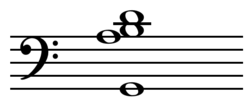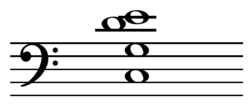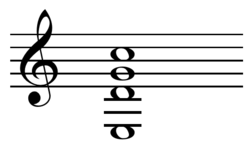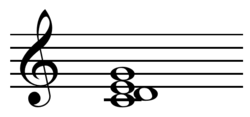- Mu chord
-
Mu chord Component intervals from root perfect fifth major third major second root A mu major chord or mu chord (signified by μ) is a somewhat unconventional name for an "add 2" or "add 9" chord. It is formed by adding a 2nd to a major triad; in other words, it is a chord constructed from the 1st, 2nd, 3rd and 5th degrees of the major scale and thus features whole-tone dissonance (in C: CEG add D featuring whole-tones C-D-E). The mu major chord differs from a sus2 chord as a sus2 chord does not contain a 3rd. The chord is notable for its frequent use by jazz-rock legends Steely Dan. According to Howard Wright one should, "think of the Steely Dan mu major chord as a rather special way of voicing and using an add2 chord."[1]
 Mu chord on G[1]
Mu chord on G[1]
Voicing was important to Steely Dan due to the integral role the keyboardist played in the band. Wright quotes Becker and Fagen's introduction to their songbook as explaining the limits of the mu chord: "Inversions of the µ major may be formed in the usual [generally unlimited] manner with one caveat: the voicing of the second and third scale tones, which is the essence of the chord's appeal, should always occur as a whole tone dissonance."[2]
 Mu chord on C.[2]
Mu chord on C.[2]
Often, the mu major chord is voiced easily on keyboards with the root (1) in the bass, and 2nd, 3rd, 5th in the upper register.[1] Part of its "sound" is the presence of two "stacked" fourths in the upper register, between 2-5 and 5-1 (although this is softened by the presence of the major third). This stacked fourths feature, also called "quartal" harmony, is more obvious when the mu major is voiced with the 3rd in the bass, and the 2nd, 5th and 1st above. The chord can also be voiced with the 9th (2nd) in the bass, although such voicings are generally known as slash chords.
Mu chords, or portions thereof, may be involved in substitution. For example C mu: CDEG may be substituted by CFGBb by retaining C in the bass and substituting FGBb for DEG.[1]
Contents
Origin of the name, and separately, the chord itself
 Extension of the Mu chord, the "Steely Dan chord" on C/E[3]
Extension of the Mu chord, the "Steely Dan chord" on C/E[3]
The reference to this chord as "mu major" has been popularized by fans of the jazz-influenced rock group Steely Dan, as well as by the band members themselves. This chord is used extensively in their work, often arpeggiated at the end of musical phrases. The "mu major sound" is a distinctive idiom of Steely Dan's style. In a 1989 interview with Paul Zollo,[3] Walter Becker explained that the use of the chord developed from trying to enrich the sound of a major chord without making it into a "jazz chord". They used it so often that it became a signature sound for the band. The reason they called it "mu major" is now forgotten, but the whole business of naming the chord was meant as a joke regarding the band's excessive use of the voicing.[3] While the name itself comes indeed from this band, the usage of the chord itself has been present for decades in jazz music from bop to free, and was especially present in the Jazz-funk era from the late '60s to the early '80s. Notable users are, amongst many others and for instance, vibes player/composer Roy Ayers, and pianist/composer Herbie Hancock. The chord/voicing technique was the same, just not named as such.
 Mu chord on E played on guitar.[2]
Mu chord on E played on guitar.[2]
External links
- http://www.steelydan.com/compuserve.html mentions mu-major chord
Sources
- ^ a b c d Howard Wright 2002-2007. "Steely Dan Mu Major Chord", Howard Wright's Home Page.
- ^ a b c Becker and Fagen. "Intro to the Steely Dan Song Book ", SteelyDan.com. Posted 05/96.
- ^ a b c "Winter 1989 interview with Walter Becker", Metal Leg: The Steely Dan Magazine, Issue 14, Fall 1990.
Further reading
- Zollo, Paul (2003). Songwriters on songwriting, p.432. Da Capo Press. ISBN 9780306812651.
- (2006). Keyboard, Volume 32, Issues 1-6, p.37. GPI Publications.
Chords By type Major · Minor · Dominant · Dominant seventh flat five · Diminished · Half-diminished · Diminished major · Minor-major · Augmented major · Augmented minor · Nondominant · Harmonic seventh chordAdded
/ omittedBy function SecondaryWith names Elektra chord · Farben chord · Hendrix chord · Mu chord · Mystic chord · Northern lights chord · Petrushka chord · Power chord · Psalms chord · So What chord · Spider chord · Tristan chord · Viennese trichord · Dream chordOther Common chord (music) · Mixed interval · Open chord · Polychord · Primary triad · Quartal and quintal · Slash chord · Subsidiary chord · Synthetic chord · Tone clusterCategories:- Chords
Wikimedia Foundation. 2010.

